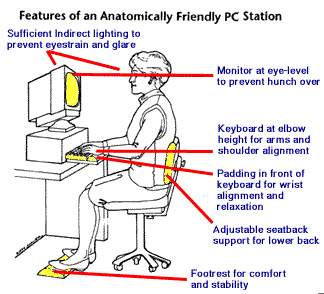Thursday, November 02, 2006
How to Keep Good Posture When Using the Computer
Computer use is becoming (has become) a major part of everyday life, and for many of us, hours may be spent in front of the monitor. However, many people don't know what to do to maintain good posture while they type away and browse the web. Possible consequences of bad posture include neck or back pains and carpal tunnel syndrome.
A good computer workstation set up should cause your body to be in a neutral position, which means that muscles and tendons should be in a relaxed state. This will reduce the chances of developing a musculoskeletal disorder. A good diagram of how you should be positioned in front of the computer is below:
The basic idea is to keep your body relaxed and make computer tasks natural and fluid instead of painful and forced. The Ririan Project has nine helpful tips for keeping good posture. I found number five particularly useful:
Other resources:
Cornell University Ergonomics Web
OSHA on Ergonomics
Image credit
A good computer workstation set up should cause your body to be in a neutral position, which means that muscles and tendons should be in a relaxed state. This will reduce the chances of developing a musculoskeletal disorder. A good diagram of how you should be positioned in front of the computer is below:

The basic idea is to keep your body relaxed and make computer tasks natural and fluid instead of painful and forced. The Ririan Project has nine helpful tips for keeping good posture. I found number five particularly useful:
On a related note, if you should develop carpal tunnel syndrome, some studies show that taking large amounts of Vitamin B-6 (pyridoxine) may be helpful. Other studies disagree.5. Wrist and Finger Postures
Keep your wrists straight while typing and while using a mouse or trackball. Avoid bending your wrists up, down, or to the sides. Use the keyboard legs if they help you maintain a comfortable and straight wrist position. Type with your hands and wrists floating above the keyboard, so that you can use your whole arm to reach for distant keys instead of stretching your fingers.Make sure you keep your fingers relaxed while typing and using a mouse. Use a soft touch on the keyboard instead of pounding keys with unnecessary force.
Also grasp the mouse gently and avoid holding a pen or anything else in your hands while you type or use the mouse. You should relax your fingers and hands between bursts of typing or mousing using a flat, straight wrist posture.
When moving your mouse, you may be more comfortable if you use your arm, not just your wrist. Choose a mouse that fits the size of your hand comfortably and is as flat as possible to minimize wrist strain.
Other resources:
Cornell University Ergonomics Web
OSHA on Ergonomics
Image credit
Technorati Tags:
Labels: Technology






